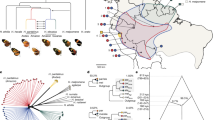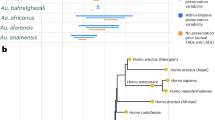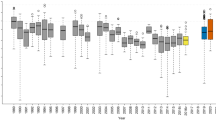Abstract
Natural communities are well known to be maintained by many complex processes. Despite this, the practical aspects of studying them often require some simplification, such as the widespread assumption that direct, additive competition captures the important details about how interactions between species impact community diversity. More complex non-additive ‘higher-order’ interactions are assumed to be negligible or absent. Notably, these assumptions are poorly supported and have major consequences for the accuracy with which patterns of natural diversity are modelled and explained. We present a mathematically simple framework for incorporating biologically meaningful complexity into models of diversity by including non-additive higher-order interactions. We further provide empirical evidence that such higher-order interactions strongly influence species’ performance in natural plant communities, with variation in seed production (as a proxy for per capita fitness) explained dramatically better when at least some higher-order interactions are considered. Our study lays the groundwork for a long-overdue shift in how species interactions are used to study the diversity of natural communities.
This is a preview of subscription content, access via your institution
Access options
Access Nature and 54 other Nature Portfolio journals
Get Nature+, our best-value online-access subscription
$29.99 / 30 days
cancel any time
Subscribe to this journal
Receive 12 digital issues and online access to articles
$119.00 per year
only $9.92 per issue
Buy this article
- Purchase on Springer Link
- Instant access to full article PDF
Prices may be subject to local taxes which are calculated during checkout



Similar content being viewed by others
References
Chesson, P. in Encyclopedia of Sustainability Science and Technology (ed. Meyers, R. A. ) Ch. 13, 223–256 (Springer, 2012).
Allesina, S. & Levine, J. M. A competitive network theory for species diversity. Proc. Natl Acad. Sci. USA 108, 5638–5642 (2011).
Volterra, V. Fluctuations in the abundance of a species considered mathematically. Nature 118, 558–560 (1926).
May, R. Will a large complex system be stable? Nature 238, 413–414 (1972).
Thuiller, W. et al. A road map for integrating eco-evolutionary processes into biodiversity models. Ecol. Lett. 16, 94–105 (2013).
Sih, A., Englund, G. & Wooster, D. Emergent impacts of multiple predators on prey. Trends Ecol. Evol. 13, 350–355 (1998).
HilleRisLambers, J., Adler, P. B., Harpole, W. S., Levine, J. M. & Mayfield, M. M. Rethinking community assembly through the lens of coexistence theory. Annu. Rev. Ecol. Evol. S. 43, 227–248 (2012).
Chesson, P. Mechanisms of maintenance of species diversity. Annu. Rev. Ecol. Syst. 31, 343–366 (2000).
Kunstler, G. et al. Plant functional traits have globally consistent effects on competition. Nature 529, 204–207 (2016).
Levine, J. M. & HilleRisLambers, J. The importance of niches for the maintenance of species diversity. Nature 461, 254–257 (2009).
Falster, D. S., FitzJohn, R. G., Brännstrom, Å., Diekmann, U. & Westoby, M. Plant: a package for modelling forest trait ecology and evolution. Methods Ecol. Evol. 7, 136–146 (2016).
Madin, J. S., Hoogenboom, M. O. & Connolly, S. R. Integrating physiological and biomechanical drivers of population growth over environmental gradients on coral reefs. J. Exp. Biol. 215, 968–976 (2012).
Connolly, S. R. & Roughgarden, J. Theory of marine communities: competition, predation, and recruitment-dependent interaction strength. Ecol. Monogr. 69, 277–296 (1999).
Smith-Gill, S. J. & Gill, D. E. Curvilinearities in the competition equations: an experiment with ranid tadpoles. Am. Nat. 112, 557–570 (1978).
Wootton, T. J. The nature and consequences of indirect effects in ecological communities. Annu. Rev. Ecol. Syst. 25, 443–466 (1994).
White, E. M., Wilson, J. C. & Clarke, A. R. Biotic indirect effects: a neglected concept in invasion biology. Divers. Distrib. 12, 443–455 (2006).
Roughgarden, J. & Diamond, J. in Community Ecology (eds Diamond, J. & Case, T. J. ) 333–343 (Harper and Row, 1986).
Schoener, T. W. Some methods for calculating competition coefficients for resource-utilization spectra. Am. Nat. 108, 332–340 (1974).
Freckleton, R. P. & Watkinson, A. R. Predicting competition coefficients for plant mixtures: reciprocity, transitivity and correlations with life-history traits. Ecol. Lett. 4, 348–357 (2001).
Billick, I. & Case, T. J. Higher order interactions in ecological communities: what are they and how can they be detected? Ecology 75, 1529–1543 (1994).
Werner, E. E. & Peacor, S. D. A review of trait-mediated indirect interactions in ecological communities. Ecology 84, 1083–1100 (2003).
Abrams, P. A., Menge, B. A., Mittlebach, G. G., Spiller, D. & Yodzis, P. in Food Webs: Integration of Patterns and Dynamics (eds Polis, G. & Winemiller, K. ) 371–395 (Chapman and Hall, 1996).
Peacor, S. D. & Werner, E. E. The contribution of trait-mediated indirect effects to the net effects of a predator. Proc. Natl Acad. Sci. USA 98, 3904–3908 (2001).
Trussell, G. C., Ewanchuk, P. J. & Matassa, C. M. Habitat effects on the relative importance of trait- and density-mediated indirect interactions. Ecol. Lett. 9, 1245–1252 (2006).
Wootton, J. T. Indirect effects and habitat use in an intertidal community: interaction chains and interaction modifications. Am. Nat. 75, 1544–1551 (1993).
Vandermeer, J. H. The competitive structure of communities: an experimental approach with protozoa. Ecology 50, 362–371 (1969).
Bairey, E., Kelsic, E. D. & Kishony, R. High-order species interactions shape ecosystem diversity. Nat. Commun. 7, 12285 (2016).
Godoy, O. & Levine, J. M. Phenology effects on invasion success: insights from coupling field experiments to coexistence theory. Ecology 95, 726–736 (2014).
Goldberg, D. E. & Werner, P. A. Equivalence of competitors in plant communities: a null hypothesis and a field experiment. Am. J. Bot. 170, 1098–1104 (1983).
Case, T. J. & Bender, E. A. Testing for higher order interactions. Am. Nat. 118, 920–929 (1981).
Anderson, T. L. & Whiteman, H. H. Non-additive effects of intra- and interspecific competition between two larval salamanders. J. Anim. Ecol. 84, 765–772 (2015).
Wilbur, H. M. Competition, predation, and the structure of the Ambystoma–Rana sylvatica community. Ecology 53, 3–21 (1972).
Shmueli, G. To explain or to predict? Stat. Sci. 25, 289–310 (2010).
Burnham, K. P. & Anderson, D. R. Model Selection and Multimodel Inference: A Practical Information-Theoretic Approach (Springer, 2002).
Adler, P. B., HilleRisLambers, J. & Levine, J. A niche for neutrality. Ecol. Lett. 10, 95–104 (2007).
Okuyama, T. & Holland, J. N. Network structural properties mediate the stability of mutualistic communities. Ecol. Lett. 11, 208–216 (2008).
Novak, M. & Wootton, J. T. Estimating nonlinear interaction strengths: an observation-based method for species-rich food webs. Ecology 89, 2083–2089 (2008).
Abrams, P. A. Implications of dynamically variable traits for identifying, classifying, and measuring direct and indirect effects in ecological communities. Am. Nat. 146, 112–134 (1995).
Dwyer, J. M., Hobbs, R. J., Wainwright, C. E. & Mayfield, M. M. Climate moderates release from nutrient limitation in natural annual plant communities. Global Ecol. Biogeogr. 24, 549–561 (2015).
Law, R. & Watkinson, A. R. Response-surface analysis of two-species competition: an experiment of Phleum arenarium and Vulpia fasciculata . J. Ecol. 75, 871–886 (1987).
Angert, A. L., Huxman, T. E., Chesson, P. & Venable, D. L. Functional tradeoffs determine species coexistence via the storage effect. Proc. Natl Acad. Sci. USA 106, 11641–11645 (2009).
Quinn, G. P. & Keough, M. J. Experimental Design and Data Analysis for Biologists (Cambridge Univ. Press, 2002).
Rao, C. R., Toutenburg, H. & Shalabh, H. C. Linear Models and Generalizations (Springer, 2008).
Venables, W. N. & Ripley, B. D. Modern Applied Statistics with S 4th edn (Springer, 2002).
Larsen, W. A. & McCleary, S. J. The use of partial residual plots in regression analysis. Technometrics 14, 781–790 (1972).
Acknowledgements
This project was made possible by funding awarded to M.M.M. by the Australian Research Council (DP140100574 and FT140100498) and to D.B.S. from the Royal Society of New Zealand (UOC-1101 and a Rutherford Discovery Fellowship). We thank H. R. Lai, X. Loy, C. Wainwright and J. HilleRisLambers for help with data collection and J. HilleRisLambers, J. Dwyer, J. Tylianakis and the Mayfield and Stouffer labs for constructive comments. We also thank X. Loy for the art used to create Supplementary Fig. 1.
Author information
Authors and Affiliations
Contributions
Authors are equal contributors to this paper. M.M.M. and D.B.S. conceived of the project and the framework together. M.M.M. collected and provided all data (with acknowledged help) and D.B.S. conducted all analyses. M.M.M. led the joint effort of writing the manuscript.
Corresponding authors
Ethics declarations
Competing interests
The authors declare no competing financial interests.
Supplementary information
Supplementary Information
Supplementary Methods; Supplementary Figs 1–3; Supplementary Tables 1–4; Supplementary References. (PDF 2093 kb)
Supplementary Data 1
Full dataset analysed in this study. This file contains an R list object, called fecundity.data, made up of six data frames (one per focal species). Within these data frames, each row (with unique identifier) contains the data for a single focal plant. The first four columns provide the following information: “Seed”: the number of seeds produced by focal plant; “focal”: focal species name; “site”: site code (B = Bendering, K = Kunjin); and “quadrat”: quadrat number. All remaining columns report densities of each potential competitor species, listed by name. Values in these “competitor” columns are abundances within the 7.5 cm radius “neighbourhood” around the focal plant. This file is also accessible from Dryad. (ZIP 0 kb)
Supplementary Data 2
This Rdata file contains an example dataset usable with Supplementary Code 2. Note that this file does not include all of the data used to generate the results presented in this paper but is simplified to better help users become familiar with our model-fitting R code. Our full dataset is available through Dryad and as Supplementary Data 1. (ZIP 14 kb)
Supplementary Code 1
This file includes the model-fitting code for our regression framework. It includes the function needed to fit fecundity models based on the following model formulations: the full and intermediate forms of the negative binomial model (Table 1 and Supplementary Table 3), a Poissonian form (not included in results), the negative binomial with quadrat included as a random effect, and the linear form and the inverse forms all presented in Supplementary Table 2. Notes for running this code with our full dataset (Supplementary Data 1) or the simpler and smaller example dataset (Supplementary Data 2) are provided at the beginning of the files. (TXT 6 kb)
Supplementary Code 2
This file provides a sample workflow for data analysis from this paper. The provided code fits the null-no competition, direct-competitive only and the full HOI-inclusive negative binomial models (equation (1)). It is designed to run with the example data file (Supplementary Data 2). This code runs much faster (when using the example data) than Supplementary Code 1 with the full dataset. (TXT 0 kb)
Rights and permissions
About this article
Cite this article
Mayfield, M., Stouffer, D. Higher-order interactions capture unexplained complexity in diverse communities. Nat Ecol Evol 1, 0062 (2017). https://doi.org/10.1038/s41559-016-0062
Received:
Accepted:
Published:
DOI: https://doi.org/10.1038/s41559-016-0062
This article is cited by
-
The low-rank hypothesis of complex systems
Nature Physics (2024)
-
Data-driven prediction of colonization outcomes for complex microbial communities
Nature Communications (2024)
-
Hypergraph reconstruction from uncertain pairwise observations
Scientific Reports (2023)
-
A density functional theory for ecology across scales
Nature Communications (2023)
-
Matrix community models for ecology and evolution
npj Biodiversity (2023)



